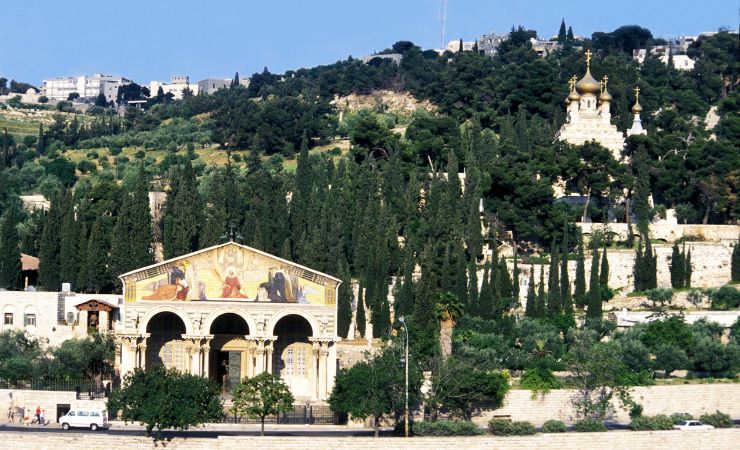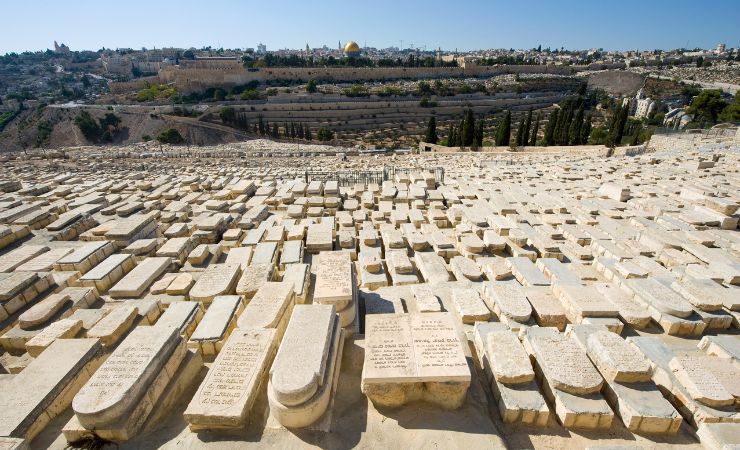The Mount of Olives: The Spiritual Summit of Jerusalem
The Mount of Olives is named after the olive groves that once blanketed its slopes. Remarkably, one can even find an olive tree there that’s believed to be over 2,000 years old. The Mountain is important to all three monotheistic faiths.

Location
The Mount of Olives is situated east of the Old City of Jerusalem. It’s separated from the Temple Mount by the Kidron Valley. This ridge, which once was adorned with olive groves, offers a panoramic view of the Old City of Jerusalem, making it a sought-after vantage point including the Golden Gate and the Lion’s Gate of the Old City.



The Mount of Olives is Significant to All the Major Monotheistic Religions
The Mount of Olives holds a significant place in the beliefs and traditions of all three Abrahamic religions: Judaism, Christianity, and Islam:
Judaism
The Mount of Olives holds a deep-rooted significance in Jewish tradition. It is frequently mentioned in the Bible, with its first reference as the “ascent of the Mount of Olives” in 2 Samuel 15. The book of Zechariah also alludes to the Mount in its prophecy concerning the end of days. According to ancient Jewish beliefs, the messianic era will dawn on the Mount of Olives. This has led to the slopes of the mount becoming the most revered burial ground in Judaism for many centuries. The prevailing belief is that those interred here will be the first to be resurrected when the Messiah arrives. Over the years, the Mount has also been a place of lamentation, especially on Tisha B’Av, as it offers a panoramic view of the Temple site, reminding the Jewish people of the Temple’s destruction.
Christianity
The Mount of Olives is intrinsically linked to the life and teachings of Jesus, making it a focal point in Christian tradition. From this mount, Jesus made his entry into Jerusalem, marking the beginning of the last week of his life. Before his Crucifixion, he delivered the Olivet Discourse, where he prophesied the fall of Jerusalem and the end of the world. The Garden of Gethsemane, nestled on the Mount’s western slopes, is where Jesus prayed before being betrayed by Judas Iscariot. After his Resurrection, it is believed that Jesus ascended into heaven from the Mount of Olives. Due to its association with these pivotal events in Jesus’ life, the mount has been a place of Christian worship since ancient times and continues to be a major pilgrimage site for Christians worldwide.
Islam
The Mount of Olives and the Temple Mount hold significant importance in Islamic eschatology. While the provided sources did not directly address the specific bridge between the Mount of Olives and the Temple Mount, Islamic tradition speaks of the “As-Sirāt,” a bridge that will be established over Hell on the Day of Judgment.
According to Islamic teachings, every individual will need to cross this bridge, which is described as being finer than a hair and sharper than a sword. The righteous will be able to cross it swiftly, moving at various speeds depending on their deeds, while those who are sinful and have wronged others will find it difficult to navigate and may fall into Hell.
The Mount of Olives and the Temple Mount, both being significant religious sites in Jerusalem, are often associated with end-time prophecies in Islamic tradition. The bridge’s concept, while not directly linking these two sites, is symbolic of the final judgment and the distinction between the righteous and the wicked.

Notable Sites and Monuments on the Mount of Olives
- Chapel of the Ascension: The Chapel (or Church) of the Ascension is a sacred site believed to be where Jesus ascended to heaven. It was originally constructed as a Christian chapel, but was later transformed into a mosque.
- Church of All Nations (Basilica of the Agony): The Church of All Nations, built by architect Antonio Barluzzi is the place of Jesus’ final prayers before his arrest. Inside, a prominent rock is believed to be the exact spot where Jesus prayed.
- Dominus Flevit (The Lord Wept): The Dominus Flevit church commemorates the moment Jesus wept for the city’s impending doom. Its unique teardrop-shaped design offers a panoramic views of the Old City.
- Pater Noster (The Church of the Lord’s Prayer): Tradition holds that Jesus taught this prayer to his disciples here. It is built on the remains of one of the four churches built by Helena, the mother of Constantine the Great in the 4th Century AD.
- Garden of Gethsemane: The Garden of Gethsemane is a tranquil spot believed to be where Jesus prayed and was later betrayed by Judas Iscariot. The Garden includes the Grotto of Gethsemane.
- Jewish Cemetery: Spanning the mount’s western slopes, this ancient cemetery has been a burial ground for over 3,000 years. The graveyard includes more than 150,000 graves.
- Augusta Victoria Hospital: Perched on the mount’s middle peak, the Augusta Victoria Hospital, originally built as a grand edifice in the early 20th century, now serves the community as a hospital. Its historical architecture and prominent tower make it a recognizable landmark on the Mount of Olives.
- Church of Mary Magdalene: This Russian Orthodox church, distinguished by its golden onion domes was established in 1888, it was built in memory of the Russian Czar’s mother, Empress Maria Alexandrovna.
Sources and Additional Reading
Wikipedia – Mount of Olives
Britannica – Mount of Olives
Laidback Trip
Nearby Sites
The Tombs of the Kidron Valley: The Kidron Valley is filled with old tombs carved into the rocks. These include the Tomb of Absalom, and the Tomb of Benei Hezir.
The Virgin Mary’s Tomb: Once below a Crusader’s church, this grotto is believed to be Mary’s final resting place.
The Gates of the Old City: Jerusalem’s Old City has these ancient gates, each with its own tale. The gate in the east are the Lion’s Gate and the Golden Gate.
Temple Mount Sifting Project: This project involves sifting through dirt from the Temple Mount. It is possible to join for a few hours.



